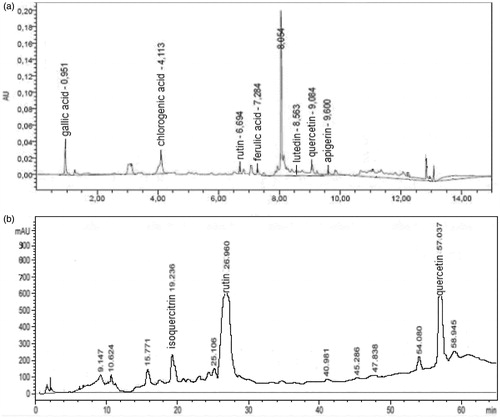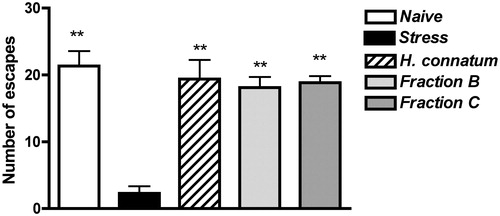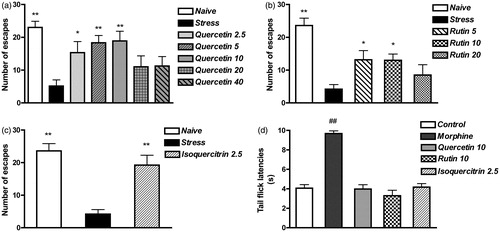Figures & data
Figure 1. Chromatograms of the ethanolic extract (a) and fraction B (b) of H. connatum. (a) UPLC chromatogram of the ethanolic extract of H. connatum. (b) RPHPLC chromatogram of fraction B of the ethanolic extract of H. connatum and identification of potential active compounds, quercetin, rutin and isoquercitrin. Retention times are expressed in min.

Figure 2. Effects of H. perforatum or H. connatum treatment on ED development. (a) Rats received vehicle (stress, n = 8), H. perforatum (0.5 g/kg or 1 g/kg, n = 5) or H. connatum (0.5 g/kg, n = 5, or 1 g/kg, n = 5) 60 min before the unavoidable stress session, and they underwent the escape test 24 h later. A group of vehicle-treated rats underwent the escape test, without unavoidable stress exposure (naive, n = 8). (b) Rats received vehicle (stress, n = 8), H. connatum (0.5 g/kg twice daily, n = 8), or fluoxetine (5 mg/kg/day, n = 8) for 14 d and, on the 15th day, they were exposed to unavoidable stress. Twenty-four hours later, rats were tested for escape. A group of vehicle-treated rats underwent the escape test, without unavoidable stress exposure (naive, n = 4). Data are expressed as mean ± SEM of the number of escapes/30 trials. **p < 0.01 versus the stress group.

Figure 3. Effects of acute treatment with H. connatum fractions on ED development. Rats received vehicle (stress, n = 7), H. connatum (0.5 g/kg, n = 5), fraction B (250 mg/kg, n = 9) or fraction C (250 mg/kg, n = 6) 60 min before the unavoidable stress session, and they underwent the escape test 24 h later. A group of vehicle-treated rats underwent the escape test, without unavoidable stress exposure (naive, n = 6). Data are expressed as mean ± SEM of the number of escapes/30 trials. **p < 0.01 versus the stress group.

Figure 4. Effects of acute treatment with quercetin, rutin and isoquercitrin on ED development and pain threshold. (a) Rats received vehicle (stress, n = 8), quercetin (2.5, 5, 10, 20 and 40 mg/kg, n = 4–8) 60 min before the unavoidable stress session and underwent the escape test 24 h later. A group of vehicle-treated rats underwent the escape test, without unavoidable stress exposure (naive, n = 6). (b) Rats received vehicle (stress, n = 5), rutin (5, 10 and 20 mg/kg, n = 5–8) 60 min before the unavoidable stress session and underwent the escape test 24 h later. A group of vehicle-treated rats underwent the escape test, without unavoidable stress exposure (naive, n = 5). (c) Rats received vehicle (stress, n = 5), isoquercitrin (2.5 mg/kg, n = 5) 60 min before the unavoidable stress session and underwent the escape test 24 h later. A group of vehicle-treated rats underwent the escape test, without unavoidable stress exposure (naive, n = 5). Data are expressed as mean ± SEM of the number of escapes/30 trials. (d) Rats received quercetin (10 mg/kg, n = 5), rutin (10 mg/kg, n = 5), isoquercitrin (2.5 mg/kg, n = 5) or vehicle (1 mL/kg, n = 5) and were tested in the tail flick apparatus 60 min later. As a positive control group, rats were treated with morphine (5 mg/kg s.c., n = 5) 10 min before the test. Data are expressed as mean ± SEM of tail flick latencies in s. **p < 0.01, *p < 0.05 versus the corresponding stress group; ## p < 0.01 versus the control group.

Table 1. Effects of quercetin, rutin or isoquercitrin acute treatment on the performance in the EPM test.
